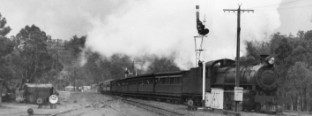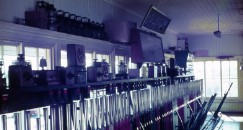Block Bell Codes
What were Bell Codes?
Bell Codes were not the same as the Morse Code used in Telegraphy and Telephony which consisted of series of 'short and long' buzzes or rings. Bell codes used by the Western Australian Government Railways (W. A. G. R.) consisted of a series of 'Beats' separated by a pause of time. An aubible example is given at the bottom of this page.
Why were they used?
Where were they located?
In Signal Boxes, Block Bells and Plungers, (if not fitted into block instruments), could be located in almost any place, but mostly they were situated on the long shelf (known as the 'Instrument Shelf') over the levers. When there were many levers, a duplicate set of plungers were provided that were connected in 'series' so that either plunger could send a Bell Code.
At stations where there was a 'Station Frame' (outdoor lever frame), the Staff Intruments were located away from the weather in a room in the station buildings and
Where were they located?
In Signal Boxes, Block Bells and Plungers, (if not fitted into block instruments), could be located in almost any place, but mostly they were situated on the long shelf (known as the 'Instrument Shelf') over the levers. When there were many levers, a duplicate set of plungers were provided that were connected in 'series' so that either plunger could send a Bell Code.
At stations where there was a 'Station Frame' (outdoor lever frame), the Staff Intruments were located away from the weather in a room in the station buildings and at remote stations or crossing loops, Electric Staff huts housed the instruments and the block bells were mounted on brackets on an inside wall near the Staff instrument.
How did they work?
Bell Codes were sent by the pressing in of a plunger. A plunger could be fitted into its own wooden case, or in the case of Winter's and Dowson's Block instruments, included in these instruments. For single line working, typically using Electric Staff Instruments, (either miniature or Large type) the plungers were not used, as a 'tapper key' or button was provided on each instrument. In both Electric Staff and Block Instrument systems, Bell Codes were received from the distant station on Block Bell units.
Each press of the plunger or key, resulted in the Bell at the remote location would give one ring, with the reverse also being true.
Note: Some models of early W. A. G. R. Instrument Shelf Block Bells show evidence of their being fitted with 'tapper keys' similar to those used in English Signal Cabins.
When there was more than one Block Bell, how did a Signalman know which one rang?
There were several shapes of Block Bells, each giving its own tone. In most signal boxes, there would only be two Block Bells, and they were set up in such a fashion in each signal box so that the same shape / tone of the bell would indicate the direction of the signal being sent. An example of this, is that that on the Perth to Fremantle line, each signal cabin had the 'round' bell on the 'Up' (Fremantle end) of shelf over the levers, and all of the 'oval' shaped bells were positioned on the 'Down' (Perth end) of each signal cabin. This aided Signalmen whenever they worked in the various signal cabins along the line, and it did not matter whether the signal cabin was orientated differently to its neighbour. The Bells usually had a letter stamped inside to denote the tone of bell they were. The shape of the bells on the South West (S. W. R.) line differed from the Eastern (E. R.) line bells by being a 'conical' (Up End) and a 'cylindical' (Down End) shape as can be seen here in this photo of the bells fitted to the Winters Block instrument at Cannington.
Note: Bell Codes shown with an * indicate that those signals are NOT preceeded by the Call Attention signal. | ||
Double Line Working - Winters; Dowson's and Lock and Block instruments | ||
Bell Code | Beats on Bell | How to be given |
Call Attention | 1 | 1 |
Is Line Clear for... | ||
(a) Express Passenger Train? | 4 | 4 Consecutively |
(b) Ordinary Passenger Train? | 4 | 3 pause 1 |
(c) Fast Goods Train? | 5 | 5 Consecutively |
(d) Empty Coach Train? | 5 | 2 pause 2 pause 1 |
(e) Through Goods Train? | 5 | 4 pause 1 |
(f) Shunting Goods Train? | 3 | 3 Consecutively |
(g) Locomotive and Brakevan? | 4 | 1 pause 3 |
(h) Light Engine or Light Engines coupled together? | 5 | 2 pause 3 |
(i) Ballast Train requiring to stop in section? | 5 | 1 pause 2 pause 2 |
Train Departure | *2 | 2 Consecutively |
Train Waiting | 7 | 3 pause 4 |
Bank engine in rear of train | *4 | 2 pause 2 |
Assisting engine in front or two trains coupled | *6 | 2 pause 2 pause 2 |
Train arrival, or obstruction removed | 3 | 2 pause 1 |
Obstruction - Danger | *6 | 6 Consecutively |
Blocking Back - INSIDE Home signal | 6 | 2 pause 4 |
Blocking Back - OUTSIDE Home signal | 6 | 3 pause 3 |
Section Cear but Station or Junction Blocked | *13 | 3 pause 5 pause 5 |
Stop and Examine Train | *7 | 7 Consecutively |
Cancelling "Is Line Clear?" or "Train Departure" signal | 8 | 3 pause 5 |
Last Train Signalled Incorrectly described | 8 | 5 pause 3 |
Train Passed without Tail Disc or Lights | *9 | 9 consecutively to the BOX IN ADVANCE; 4 pause 5 to the BOX IN REAR. |
Train Divided | *10 | 5 pause 5 |
Shunt train for following train to pass | *11 | 1 pause 5 pause 5 |
Vehicles running away on right line | *14 | 4 pause 5 pause 5 |
Vehicles running away on wrong line | *12 | 2 pause 5 pause 5 |
Cancel bank engine in rear of train | 12 | 8 pause 2 pause 2 |
Speak on Telephone | *7 | 4 pause 2 pause 1 |
Opening of signal-box | 15 | 5 pause 5 pause 5 |
Closing of signal-box | 17 | 7 pause 5 pause 5 |
Testing Bells | 16 | 16 consecutively |
Testing Controlled Signals | 20 | 5 pause 5 pause 5 pause 5 |
Special Attention | 12 | 4 pause 4 pause 4 |
Cancel Back Lock | 9 | 4 pause 1 pause 4 |
Release Switch | 6 | 1 pause 4 pause 1 |
Single Line Working - Electric Staff - Large and Miniature types | ||
Bell Codes additional to the above, used specifically for Electric Staff Working | ||
Bell Code | Beats on Bell | How to be given |
Release Staff for Shunting | 7 | 5 pause 2 |
Shunting completed - staff replaced | 7 | 2 pause 5 |
Shunting in rear of departing train | 6 | 5 pause 1 |
Shunting in rear of departing train completed | 6 | 1 pause 5 |
Vehicles running away | *12 | 2 pause 5 pause 5 |
Engine of last train broken down in section | 6 | 2 pause 1 pause 2 pause 1 |
Relief engine to remove breakdown in section | 12 | 4 pause 2 pause 4 pause 2 |
Return Bank Engine | *9 | 2 pause 3 pause 4 |
Bank Engine returned with key | 9 | 4 pause 1 pause 4 |
Cancel Bank Engine in Rear of Train | 12 | 8 pause 2 pause 2 |
Testing Instruments and bells | 16 | 16 consecutively |
Transference of staffs by Maintainer | 16 | 4 pause 4 pause 4 pause 4 |
This audio file is an example of Winters Block working on the South West Railway - (suburban section. It is a simulation set in the Maddington Signal Box Circa 1969 that was created, performed and recorded by Ric Edwards (speaking and playing the part of the Maddington Signalman) and C J E French in the preserved Claremont Signal Cabin using genuine Winters Instruments during 2003.


